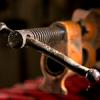So I am going at a Roubo style bench build following (more or less) the benchcrafted split top plans. I haven't actually decided whether to split or not yet, but in thinking about this, I started pondering wood movement a lot.
I can't for the life of me find anywhere in the plans that the spax screws driven through the upper rails into the tops are in elongated holes? Am I missing that or is it just assumed we will do it (or does benchcrafted think it unnecessary?)
Speaking more generally, do you typically elongate (such as an oval) the clearance hole, or do any of you sometimes do a pivoting type of hole (creating almost an hour glass) so the screw actually levers rather than the wood sliding (can wood even slide past a tightened lag or bolt?)
Last question here concerning movement: At what point do you leave clearance in a mortise for tenon movement. I ask for the stretchers and the top mortises both. I have seen recommendations for double tenons when a tenon would be too large otherwise (I think its usually over 4") but I don't see how two tenons coming from the same piece of wood wouldn't move the same distance as one large tenon...? I wanted to make some really large legs, but if they go at 6" or so I want to ensure a tight tenon through all seasonal movements.
Thanks for any thoughts on all this moving
Tyler




 Reply With Quote
Reply With Quote






